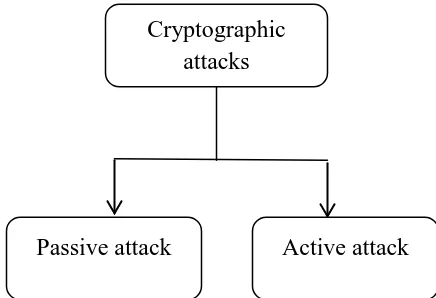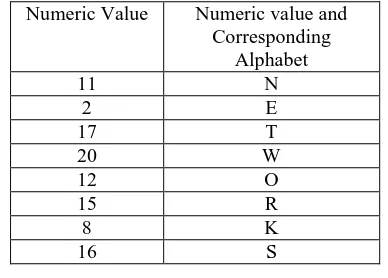417
An Automatic Generated Symmetric key Based Technique
for Encryption and Decryption of Text Data
Roshan M. PandavP
1
P
, Vijay Kumar VermaP
2
ME StudentP
1
P
, Asst. ProfessorP
2
P
, Lord Krishna College of Technology, Indore, M.P., IndiaP
1,2
roshan.pandav67@gmail.comP
1
P
,vijayvermaonline@gmail.comP
2
Abstract:-Informationsecurity is one of the
most challenging aspects ofcommunication.In
symmetric key cryptographic algorithms
singlekey is used for both encryption and
decryption process. There are several algorithm
have developed for symmetric encryptionfor
example DES, AES, Blowfish, RC5, IDEA are
some of them. Every algorithm usesdifferent
block size, key size and processing method.
Thesealgorithms only accept English alphabets,
numerical valuesand special symbols as
plaintext. The cipher text will be adocument
which is in the form of alphabets or
specialcharacters or numbers or combination of
all. In this paper we proposed an efficient
symmetric key cryptographic algorithm which
automatically generate key based on the length
of the text.
Keywords:-Symmetric, Asymmetric,
Cryptography, Automatic, encryption,
decryption.
1. INTRODUCTION
Symmetric key encryption scheme has five
components 1.Plaintext, 2.Encryption algorithm,
3. Secret key, 4. Cipher text,5. Decryption
algorithm.Cryptographic attacks are mainly
classifiedas two types, namely passive attack
and active attack. Goalof Passive attack is just
read the information it does notchange the
content of the message, for example of
messagecontent it only read the content of
message withoutpermission. Where as in active
attack, not only read theinformation and also
modifying the content of the message.For
example replay attack accesses the message that
send tothe receiver and it sent its own message
content to thereceiver as like sender.
Figure 1 Types of cryptographic attacks Cryptographic
attacks
418
II.CLASSIFICATIONS OF CRYPTOGRAPHY
A cryptography system is mainly classified into
threetypes 1. Symmetric key cryptography, 2.
Asymmetric keycryptography 3. Hash functions.
A symmetric keycryptography uses same secret
key by sender and receiverfor encryption and
decryption respectively. Asymmetric orpublic
key cryptography uses public key by sender
forencryption which is known to all and private
key whichknown by the receiver for decryption
for example.The hash function
usesmathematical transformation to irreversibly
encryptinformation. Fig 2illustrates types of
cryptographic techniques.
Figure 2 types of cryptographic techniques
III. LITERARTURE REVIEW
In 2011 K.Govinda and Dr.E.Sathiyamoorth
proposed “Multilevel Cryptography Technique
Using Graceful Codes. Theyproposed multilevel
cryptography technique for data
encryption-decryption using graceful codes[1].
In 2012 Monika Agrawaland Pradeep Mishra
proposed “A Comparative Survey on Symmetric
KeyEncryption Techniques”. They present a
detailed study of most ofthe symmetric
encryption techniques with their advantages and
limitations over each other.They give a detailed
study of the popular symmetric key encryption
algorithms such as DES, TRIPLEDES, AES,
and Blowfish. Symmetric Key algorithms run
faster than Asymmetric Key algorithms such as
RSAetc. and the memory requirement of
Symmetric algorithms is lesser than
Asymmetric encryption algorithms [2].
In 2013 Krishna Kumar
PandeyandVikasRangari Proposed “An
Enhanced Symmetric Key Cryptography
Algorithm to Improve Data Security “.The
proposed work uses enhanced symmetric key
encryption algorithm, in which same structure
of encryption and decryption procedure
algorithm is used. In conventional encryption
methods the key for encryption and decryption
is same and remain secret. The algorithm uses
key generation method by random number in
algorithm for increasing efficiency of algorithm.
The algorithm use key size of 512 bits for Symmetric key
cryptography
Asymmetric key cryptography
419 providing better security and it also provide the
concept of internal key generation at receiver
end on the basis of 512 bits key which will
entered by the sender[3].
In 2013 Sruthi B. Asok, P. Karthigaikumar,
Sandhya R and Naveen Jarold K, Siva Mangai
“IRIS Based Cryptography”. Theyimplemented
Iris based cryptography in proposed work.
Secret key is generated from iris image.
Randomness checkis conducted for the key
sequence. In AES information isencrypted and
decrypted using the key[4]
In 2013 Deepak Nagde, Raviraj Patel,
Dharmendra Keld proposed“New Approach for
Data Encryption using Two WayCrossover”.
They proposed a new approach for datasecurity.
They use the concept of genetic algorithms
incryptography along with the randomness
properties of MASmethod. This total way of
transferring secret information ishighly safe and
reliable. So without the knowledge of
thepseudorandom sequence no. one will be able
to extract themassage.In the feature work we
plan to design sophisticated softwarebased on
this technique which will target to use in
highlysecure multimedia data transmission
application[5].
In 2014 Mitali1, Vijay Kumar and Arvind
Sharma proposed “A Survey on Various
Cryptography Techniques”.The survey is done
on some of the more popularand interesting
cryptography algorithms currently in use
andtheir advantages and disadvantages are also
discussed. Theypaper provides a fair
performance comparison between thevarious
cryptography algorithms on different settings of
datapackets. They presents the
performanceevaluation of selected symmetric
algorithms. The selectedalgorithms are AES,
3DES, Blowfish and DES. Thepresented
simulation results show the numerous
points.Firstly it was concluded that Blowfish
has betterperformance than other algorithms
followed by AES.3DES has least efficient of all
the studied algorithms[6].
In 2014 Ashwini R. Tonde, Akshay P. Dhande
proposed “Review Paper on FPGA Based
Implementation of Advanced Encryption
Standard (AES) Algorithm”. They proposed
FPGA-based implementation of the Advanced
Encryption Standard(AES) algorithm. This
implementation is compared with other works to
show the efficiency. The design uses an
iterativelooping approach with block and key
size of 128 bits, lookup table implementation of
420
IV. PROPOSED METHOD
Encryption Method
Consider a simple text NETWORKS
Now the length of original string NETWORKS
is counted, which is 8. Now the length of
original string NETWORKS is counted, which
is 8.
Since 8 is even number, the Key is generated
using (n/2) i.e. 8/2=4 or else the key generated
should be (n+1)/2).
Now the key i.e. letter at position 4 is W and key chosen will be word‟s corresponding numeric value i.e. k=23 (consider A=1, B=2…
Z=26)
Original text
NV D=(NV+K)/26
replace with ASCII value
N 14 75
E 5 81
T 20 76
W 23 72
O 15 66
R 18 84
K 11 79
S 19 80
Table 1 original text and its ASCII text after apply round 1 of proposed method
Now apply round 2
Binary Value
Logical NOT
Convert into decimal and replace
with ASCII Character
01001011 10110100 -|
01010001 10101110 «
01001100 10110011 |
01001000 10110111 Π
01000010 10111101 ٧
01010100 10101011 ½
01001111 10110000 ¿
01010000 10101111 »
Table 2cipher text after round 2 proposed methods
Finally we got so finally the chipper text is
-|«|Π٧½¿»
Decryption Process
Apply the revers procedure of encryption technique
Decimal Equivalent of encrypted data
Binary Value with logical
NOT
ASCII Value
180 10110100 11
174 10101110 2
179 10110011 17
183 10110111 20
189 10111101 12
171 10101011 15
168 10110000 8
175 10101111 16
Table 3reverses of round 2 of proposed method
Text Obtained – KQLHBTOP
Apply Reverse Transposition as Text Obtained:
- KBQTLOHP
Numeric Value Numeric value and Corresponding
Alphabet
11 N
2 E
17 T
20 W
12 O
15 R
8 K
16 S
421
V. PROPOSED ALGORITHM
Step 1: Count the length of String
Step 2: If length is evenCalculate key (K) for
using n/2, Calculate a numeric Value by
Considering A=1, B=2 …Z=26and
elseCalculate key (K) for using n/2, Calculate a
numeric Value by Considering A=1, B=2
…Z=26
Step 3: calculate Key (K) (n+1)/2, Calculate a
numeric Value by Considering A=1, B=2
…Z=26.
Step 4: Apply using formula C= (NV+K) / 26;
where C is cipher text, NV plain text
numeric value and key K and replace
with ASCII value.
Step 5: Convert into binary format and apply
logical NOT.
Step6: Generator Decimal number and replace
with corresponding character.
Step7: Final got chipper text.
VI. GRAPHS AND ANALYSIS
Figure 3 Analysis graph
We have implemented the proposed algorithm
and Hybrid symmetric approach using VB Dot
net 2010 .We use simple text file to encrypt and
decrypt the data . From the graph it clear that
the proposed method perform well as compared
to hybrid symmetric approach.
VII. CONCLUSION
We proposed an efficient anautomatic generated
symmetric key based technique for encryption
and decryption of Text Data. The main objective
is to convert the text into a crypt from so
analysis becomes tedious and confusing. The
algorithm providesautomated generated key, so
that the key cannot be identifiedeasily. In future
we can apply some numerical calculation and
can also be applied to the image database. The
algorithmcan also be applied to the numeric data
in future.
VIII. REFERENCE
[1] Prof K.Govinda, Dr.E.Sathiyamoorth
proposed “ Multilevel Cryptography
Technique Using Graceful Codes” Volume
2, No. 7, July 2011 Journal of Global
Research in Computer Science
[2] Pratap Chandra Mandal Evaluation of
performance of the Symmetric Key
Algorithms: DES, 3DES, AES and Blowfish
Volume 3, No. 8, August 2012 Journal of
Global Research in Computer Science
0 2000 4000 6000 8000 10000
10 50 100
Tim
e in
m
illis
ec
on
ds
Size of File in KB
Hybrid Symmetric Approach
422 [3]Monika AgrawalPradeep Mishra“A
Comparative Survey on Symmetric
KeyEncryption Techniques”International
Journal on Computer Science and
Engineering (IJCSE)ISSN:ISSN :
0975-3397 Vol. 4 No. 05 May 2012
[4] Deepak Nagde, Raviraj Patel, Dharmendra
Kelde “New Approach for Data Encryption
using Two WayCrossover”International
Journal of Computer Science and
Information Technologies, Vol. 4 (1) , 2013,
58 – 60
[5] Krishna Kumar PandeyVikasRangariAn
Enhanced Symmetric Key Cryptography
Algorithm to Improve Data Security
International Journal of Computer
Applications (0975 – 8887) Volume 74– No.
20, July 2013
[6]Sruthi B. Asok, P. Karthigaikumar, Sandhya
R, “Naveen Jarold K4, Siva MangaiIRIS
Based Cryptography” International Journal
of Advanced Research in Computer and
Communication EngineeringVol. 2, Issue 2,
February 2013
[7]Mitalil, Vijay Kumar and Arvind SharmaA
Survey on Various Cryptography
TechniquesInternational Journal of
Emerging Trends & Technology in
Computer Science (IJETTCS)Web Site:
www.ijettcs.org Email:
31TU
editor@ijettcs.orgU31TVolume 3, Issue 4,
July-August 2014 ISSN 2278-6856
[8]Surabhi Shah Megha Singh Neha Joshi A
New Encryption Algorithm to Increase
Performance & Security through Block
Cipher Technique Volume 4, Issue 9,
September 2014 ISSN: 2277 128X
International Journal of Advanced Research
in Computer Science and Software
Engineering
[9] Udepal Singh, Upasna Garg”An ASCII
value based text data encryption System” .
International Journal of Scientific and
Research Publications, Volume 3, Issue 11,
November 2013 1 ISSN 2250-3153.
[10]Soubhik Kumar Dey, Mr. Tarak
Nandy, “A Symmetric Key Cryptographic
AlgorithmIPASJ International Journal of
Computer Science (IIJCS)Volume 2, Issue



